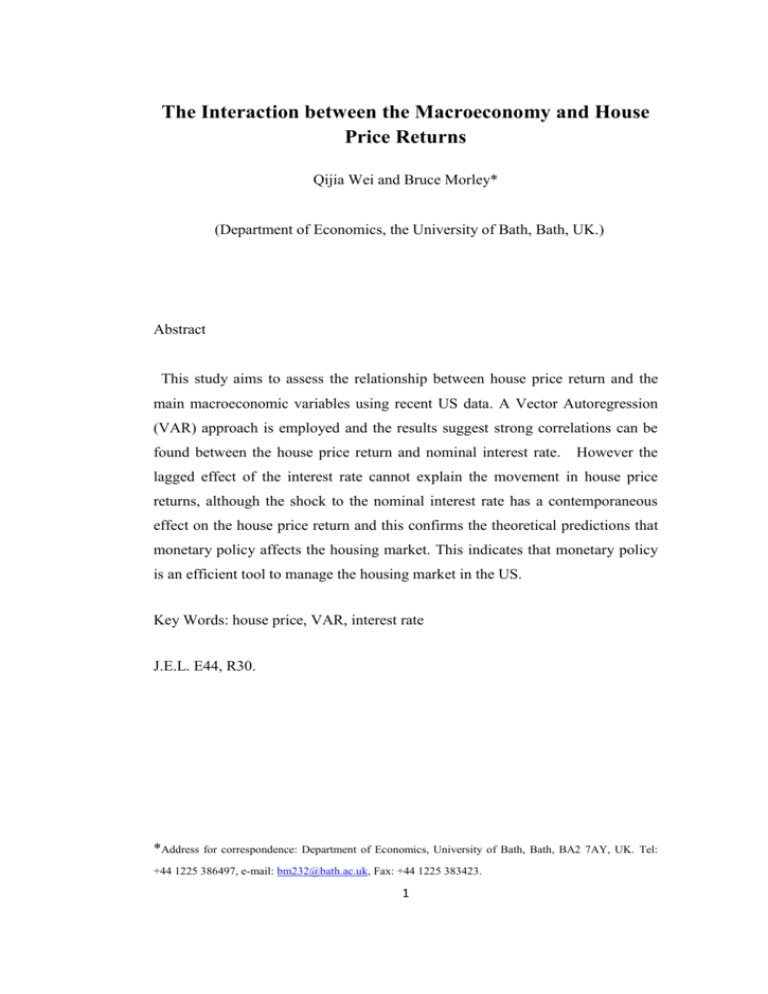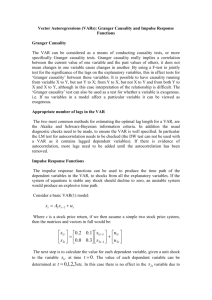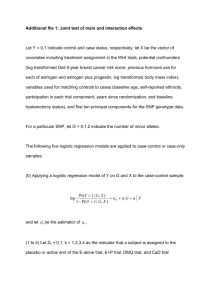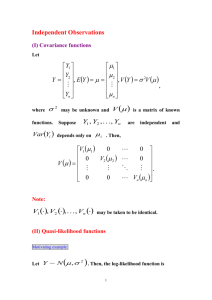The Interaction between the Macroeconomy and House Price Returns
advertisement

The Interaction between the Macroeconomy and House Price Returns Qijia Wei and Bruce Morley* (Department of Economics, the University of Bath, Bath, UK.) Abstract This study aims to assess the relationship between house price return and the main macroeconomic variables using recent US data. A Vector Autoregression (VAR) approach is employed and the results suggest strong correlations can be found between the house price return and nominal interest rate. However the lagged effect of the interest rate cannot explain the movement in house price returns, although the shock to the nominal interest rate has a contemporaneous effect on the house price return and this confirms the theoretical predictions that monetary policy affects the housing market. This indicates that monetary policy is an efficient tool to manage the housing market in the US. Key Words: house price, VAR, interest rate J.E.L. E44, R30. *Address for correspondence: Department of Economics, University of Bath, Bath, BA2 7AY, UK. +44 1225 386497, e-mail: bm232@bath.ac.uk, Fax: +44 1225 383423. 1 Tel: 1. Introduction Following the recent financial crisis there has been a debate over whether house price variables should be considered by policy makers, particularly when deciding on the optimal monetary policy. This could involve including them in a simple Taylor rule (Filardo, 2000). There is evidence to suggest that the housing market plays an important role in the macroeconomy and also the performance of the economy could affect the housing market. As a result of this inter-relationship, it is more appropriate to analyse the relationship between housing markets and the macroeconomy in a system which can assess the dynamic interrelationship between housing and the relevant macroeconomic factors. The aim of this paper is to contribute to the recent literature and discussion on the macroeconomy and housing returns. This paper’s main contribution is through adding the variables related to the Taylor rule to a VAR framework to assess the dynamic relationship between them. It also adds different measures of house prices not just the usual house price index but also house price return. Recent studies, such as McDonald and Stokes (2011) have found that the interest rate affects the housing market and excessively low nominal interest rates were the main reason for the housing market crisis and subsequent financial crisis in 2008. Similarly Ferson and Harvey (1991) found that the Treasury Bill rate, interest rate term structure, and unexpected inflation rate affected the return on real estate. In addition there is a substantial amount of evidence to suggest that real estate price movements can affect the economy as a whole (Case et al, 2001). The first channel is via the wealth effect because owning a house means that households 2 have assets in hand and can convert it into cash when necessary. Therefore, the increased price of a house means the wealth of households is rising. Usually, with the increase in wealth, people will be able to enjoy more consumption and therefore the economy expands. The second channel is named the credit effect because a house can be used as collateral when households need loans from the banks. With the increase in house prices, the value of collateral is increasing and people can receive more credit from financial institutions and therefore they have more ability to consume products. The final channel, which is the most complex is through financial derivative products, which are secured by housing assets. These products link the mortgage market, housing market and financial market together. Any change in house prices will affect the other two markets and therefore create shocks to the financial system and economy. Thus, the housing market is relevant to the central banks, where their aims are to keep the price and economy stable. Other studies which have used the VAR approach to assess the relationship between the housing market and macroeconomy include Brooks and Tsolacos (1999), who employed a vector autoregressive model to reveal the relationship between macroeconomic and financial variables and UK property returns. Similarly Goodhart and Hofmann (2008) examine the linkages between UK house prices, money, credit and the macro economy. Both UK studies found interest rates and inflation affected house prices. Other studies finding evidence of a similar relationship include Watuwa and Scotia (2008), who concentrated on the effects of economic and financial factors on real estate investment, choosing property returns, the nominal interest rate, and growth rate of industrial production, unexpected inflation, dividend yields and the interest rate spreads. 3 They also employed a VAR model to investigate the relationship between these variables for Canada. Other countries have also been studied, such as Chang, Chen and Leung (2011), who examined the dynamic housing returns in Singapore again using a VAR. Iacoviello (2000) employed the VAR model to investigate the relationship between interest rates and house price movements for Europe. Although the studies often come to different conclusions, overall there appears to be a reasonably close link between the housing market and wider economy. The remainder of this paper is organized into three parts. Firstly, the methodology used is discussed, then secondly, the empirical section using the VAR, Impulse response functions and variance decomposition will be carried out and finally the conclusions will be made and policy implications discussed. 2. Methodology The VAR model usually assumes all the variables are endogenous. According to Sim(1980) and McNees (1986), the VAR model can give better forecasts compared with structural simultaneous equations. A reduced form VAR can be expressed as follows: Yt = α0 + A1 Yt−1 + A2 Yt−2 + ⋯ + An Yt−n + ut Where Y denotes a vector, which includes m observed variables for research, and the VAR systems contained n lagged variables and noise term vector. (1) is is a white matrix. The variables on the right hand side (RHS) are all predetermined variables and the error terms are serially uncorrelated. And therefore, each separate equation in the system can be 4 estimated by OLS and consistent and asymptotically efficient estimators can be obtained. The purpose of employing the VAR model is to investigate whether the explanatory variables have significant causal effects on the dependent variables, and therefore the Granger causality tests can be used for this purpose. Suppose Y is the vector containing different variables and the lag length is 2. A VAR (2) can be expressed as: 𝑏11 ( ⋮ )=( ⋮ )+( ⋮ 𝛼𝑚0 𝑌𝑚𝑡 𝑏𝑚1 𝑌1𝑡 𝛼10 𝑐11 ⋯ 𝑏1𝑚 𝑌1𝑡−1 ⋱ ⋮ )( ⋮ ) + ( ⋮ 𝑌𝑚𝑡−1 𝑐𝑚1 ⋯ 𝑏𝑚𝑚 ⋯ ⋱ ⋯ 𝑐1𝑚 𝑌 ⋮ ) ( 1𝑡−2 ⋮ ) (2) 𝑐𝑚𝑚 𝑌𝑚𝑡−2 There are two further methods to determine the dynamic properties of the VAR, which are the impulse response function and the variance decompositions. Based on the VAR, we investigate the effect of monetary policy on house price returns and also see the relationships between pre-specified macro-economic variables and the house price return. These variables include industrial production, the consumer price index (CPI) which is used to calculate the inflation rate, the nominal federal funds rate, the interest rate spread, nominal private credit, and the house price index of the US which is used to calculated house price returns. The industrial production index (denoted IP) is used because there is no monthly data for GDP. One hypothesis is that the increase in industrial production may increase the house price return because a boom in the economy gives more confidence to the investors. 5 The Federal funds rate (denoted I) is an indicator of US monetary policy. This rate contains information about the economy since it reflects the central banks’ reaction to the movement of the economy and is a very important determinant of households’ consumption and investment decisions. All other tools, such as open market operations, setting the reserve requirement and so on, aim to vary this rate via affecting the demand and supply of money. The increase of the federal funds rate indicates a tight monetary policy and therefore will limit the development of the housing market. Inflation affects the asset markets such as stock markets and property markets because investors will require a higher risk premium when they believe there is a risk of future inflation. Moreover, inflation will also affect individual’s consumption because if households expect future inflation they will increase their current consumption. The inflation rate is calculated by the percentage change of the CPI. In theory, no agreement has been reached on what the effect of inflation on house price return is or other asset price returns. The interest rate spreads (denoted SP) are measured by the difference between the return of the 10-year Treasury Bonds and the three-month Treasury bill rate. If the spread increases, it means that the investors are uncertain about the future direction of the economy and therefore it signals that the risk of the economy is increasing. According to the asset pricing model, the house price equals the discounted expected future return. Therefore, an increase in the risk means the interest spread will increase requiring a higher discount rate and therefore house prices will fall. The house price return (denoted HPR) is the percentage rate of change 1 in the house price index based on the Standard and Poor (S&P) 1 There are many other forms the house price measure can take, for instance Morley and Wei (2012) use a variable measuring house price uncertainty, based on the conditional variance from an EGARCH model. 6 Case-Shiller index. The reason the house price return is used rather than the price alone, is that the return is of concern to most investors involved in the housing market. The Money supply (denoted M) is also included and is obtained from the St Louis FRED database (USA, M2 stock). M2 measures the money supply in circulation and is an indicator for forecasting inflation. Including this variable into the VAR systems enables one to determine whether the money supply affects the house price return. In theory, the increase in the money supply creates more credit for the individuals because more money increases the ability of the banks to give loans to investors, and therefore may create a rise in the housing market. When nominal interest rates reach approximately zero, then changes to the money supply, such as through Quantitative Easing (QE) can be a useful tool to stimulate the economy. 3. Results and discussion All the data used is monthly running from 1987m01 until 2007m04 for the USA. The first step is to check the correlations among different variables. Table 1 provides the summary statistics for the variables included in the VAR model. Table 2 presents simple contemporaneous correlations. There is a negative correlation between the house price returns and the nominal interest rate, indicating that when the house price return is high, as expected the nominal interest rate is low. This is a similar result to other empirical findings, which show that usually when the housing market booms, monetary policy is too loose. There is also as expected a negative correlation between house price returns and the inflation rate, as well as house price returns and interest rate spreads 7 Table 2 also shows the pairwise correlations for variables at lag 12. The magnitude of the correlation is not much different from those earlier in this Table. For example, after one year, there is still a strong correlation between the industrial production and the money supply. When creating the VAR, the Akaike information criterion (AIC) suggests the optimal lag length is 4. This result is similar to other studies, such as Ivanov and Kilian (2005) using monthly data and a VAR model. With four lags, there is no residual autocorrelation in the VAR, indicating that the chosen lag length is appropriate. The Granger Causality tests, reported in Table 3, are joint significance tests for the lagged explanatory variables in each equation. The results show that as expected the interest spread, industrial production, and the interest rate ‘Granger Cause’ the money supply. The house price returns appear not to ‘Granger Cause2’ the money supply and vice-versa. A similar relationship is also found between the house price return and the interest rate spread. Therefore, in the sample period from 1987 until 2007, movements of the house price return are not followed by movement of the money supply or interest rate spread, and vice-versa. House price return and industrial production Granger cause each other, or in other words it is possible to show that an innovation in one variable is followed by changes in the other. Also House price returns ‘Granger cause’ inflation, however, inflation did not ‘Granger cause’ house price returns. House price returns ‘Granger cause’ the nominal interest rate but not vice-versa. Overall there is little evidence that the wider macroeconomy or financial 2 The Granger causality test does not necessarily suggest whether the movement of one variable can be attributed to the changes of the other variable. If a Granger causality test is significant, it can mean that the movement of one variable is followed by another variable, rather than the reason for one variable’s changes being attributed to the other variable in the Granger causality test. 8 sector, except industrial production have much causal effect on the housing market in the USA, which reflects similar results from a UK study by Brooks and Tsolacos (1999). In order to investigate the dynamic relationship between house price returns and other macroeconomic variables, the variance decomposition of the house price return has been employed, to assess whether the innovations in house price returns can be attributed to its own shocks or shocks to other variables. Table 4 shows the variance decomposition of the house price return for 1, 2, 3,4,5,12,24 steps ahead and the ordering3 for the variables is INF, LIP, HPGR, SP, I, LM2. The ordering of the variance decomposition is based on the following economic theory, the increase of the money supply will change the nominal interest rate, if the money demand is not changed in the short-term and therefore the spread of the interest rate will change. The varying of the risk premiums affects the house prices and therefore the house price return, which finally affects the output for the economy, which can then cause the inflation. Therefore, the ordering is shown as: INF, LIP, HPGR, SP, I, LM2. Table 3 reports the variance decomposition for when the forecast horizon periods are 2 years. The shock to the house price return accounts for 54% of the variation in the house price return; the shock to the interest rate spread accounts for 17.7% of the variation in the house price return and the nominal interest rate explains 20.8% of the variation. This suggests, shocks to the house price return, the risk of the market, and the nominal interest rate explain more than 90% of the movement of the house price return, indicating that these variables are good at transmitting the effects of the shocks 3 There is another view on ordering suggested by Lutkepohl(1991), which is that if the residual of the VAR is almost independent it is not necessary to choose the ordering for the variance decomposition. 9 to the housing market. The shocks to house price return accounts for the biggest proportion of the variation in the house price return, indicating that the house price return series has been a useful source of information for predicting the movement of returns in the housing market. The impulse response functions are shown in Figure 1. The impulse responses show similar results to those of the variance decomposition. Shocks to the money supply do not affect the house price return, even 24 months later. The shock to inflation also does not affect the system and the response of the house price return to the shock to inflation is very small and converges to 0 after 20 months. The house price growth rate did not react to the shocks to output initially until the end of the first year. After the first year, the response increases, however the magnitude of the response is small. When there is a shock to the interest rates spread, the house price return series reacts and the magnitude of the response increases, showing a persistent trend because the response of the house price returns to the shocks to the market risk do not die away, even after 2 years. When there is a shock to the nominal interest rate, there is a negative response in the house price return and this effect does not die away even after 24 months, indicating that monetary policy affects the house price return significantly and shocks to the interest rate, such as the large falls in the early 2000s play an important role in affecting the housing market. This relationship suggests that monetary policy before the financial crisis can be attributed to the over development of the housing market in the U.S. The shocks to the house price return itself also has significant effects on the house price return, and therefore we can say that the house price return itself contains useful information for predicting future house prices. 10 4. Conclusions This study provides a VAR framework to analyse the relationship between house price returns and other relevant macroeconomic variables. Following the recent financial crisis which began in the housing market, the link between the house price return and other variables has become increasingly important. However much of the literature suggests the relationship between the housing market and macroeconomy is two way, facilitating the use of the VAR approach and the results suggest for many variables the relationship with the housing market is bi-causal, although mostly from the housing market to the macroeconomy. The Granger Causality tests show that mainly industrial production ‘Granger Causes’ the house price return. However, variance decomposition shows that only innovations in house price growth, spread premium and interest rates can explain the variations of the house price return. The variance decomposition suggests that the shocks to interest rates, spread rates and house price returns can be used to explain the shocks to the house price return, which confirms the fact that monetary policy affects the housing market. There is some evidence that the housing market ‘Granger causes’ the interest rate. This suggests models to determine the appropriate interest rate as a part of the wider monetary policy, such as the Taylor rule may benefit from the inclusion of some measure of the housing market. Given the importance of the housing market to the financial crisis, its inclusion in models aimed at predicting important monetary measures, could help form the basis for more appropriate economic policies in future. Future research needs to incorporate alternative measures of the housing market, such as measures of housing risk. 11 References Brooks,C. and Tsolacos, S. (1999) The Impact of Economic and Financial Factors on UK Property Performance. Journal of Property Research16:139-152. Case, K, Shiller, R., and Quigley, J. (2001) Comparing Wealth Effects, the Stock Market against the Housing Market. Advances in Macroeconomics, Berkeley Electronic Press.5, 1235-1245. Filardo. A. (2000) Monetary policy and asset prices, Economic Review, 3: 11-37. Granger,C.W.J.,(1969) Investigating Causal Relations by Econometric Models and Cross-Spectral Methods. Econometrica 37: 424-438. Iacono, (2008) Home Price-to-Income Ratio and Interest Rates. Available from: http://seekingalpha.com/article/11705-home-price-and-income-ratio-chart. Iacoviello, M (2000) House Prices and the Macroeconomy in Europe: Results from a Structural VAR Analysis, Working Paper Series18, European Central Bank. Inoue.T. and Hamori, S. (2009) An empirical Analysis of the Monetary Policy Reaction Function in India. IDE discussion paper No.200 Ivanov, V. and Kilian, L. (2001) A Practitioner's Guide to Lag-Order Selection for Vector Autoregressions'.CEPR Discussion Paper no. 2685. London, Centre for Economic Policy Research. 12 Lutkepohl,H.(1991) Introduction to Multiple Time Series Analysis, Spring-Verlag, Berlin. McDonald .J.F and Stokes, H.H., (2011) Monetary Policy and the Housing Bubble. Journal of Real Estate Finance and Economics (forthcoming). McNees, S.K., (1986) Forecasting Accuracy of Alternative Techniques: A Comparison of US Macroeconomic Forecasts. Journal of Business and Economic Statistics 4: 5-15. Morley, B. and Wei, Q. (2012) The Taylor Rule and House Price Uncertainty, Applied Economics Letters, 19, 1449-1453. Runkle, D.E., (1987) Vector Autoregressions and Reality, Journal of Business and Economic Statistics, 5: 437-42. Sims, C. (1980) Macroeconomics and Reality. Econometrica 48:1-48. Tsai. I and Chen, M. (2009) The Asymmetric Volatility of House prices in the UK. Property Management 27: 80-90. Tsatsaronis, K. and Zhu, H., (2004) What Drives Housing Price Dynamics: Cross-Country Evidence BIS Quarterly Review: 65-78. Wadhwani, S.B. (2008) Should Monetary Policy Respond to Asset Price Bubbles? Revisiting the Debate. National Institute Economic Review, No. 206 13 Walsh,C.E,.( 2003) Implications of a Changing Economic Structure for the Strategy of Monetary Policy. Proceedings, Federal Reserve Bank of Kansas City, 297-348 Watuwa, R.N. and Scotia, A. (2008) The Impact of Economic and Financial Factors on the Performance of Property Investment in Canada. Journal of International Finance and Economics, 8: 157-164. Williams, J.C. (2003) Simple Rules for Monetary Policy. Federal Reserve Bank of San Francisco Economic Review. 14 Table 1 Descriptive Statistics Mean Median Maximum Minimum Std. Dev. Skewness Kurtosis Jarque-Bera Probability Sum Sum Sq. Dev. Observations HPGR I INF SP IP M2 0.062533 0.076349 0.186473 -0.06535 0.063678 -0.01484 1.800547 13.91582 0.000951 14.50755 0.047809 0.0522 0.0985 0.0098 0.02179 0.098967 2.5445 2.384358 0.303559 11.0917 0.030072 0.028791 0.060999 0.010618 0.010489 0.655739 3.187577 16.96654 0.000207 6.976653 0.015611 0.01425 0.0369 -0.00739 0.012205 0.097942 1.76468 15.12239 0.00052 3.621641 82.40397 85.3454 105.207 62.7503 14.1367 -0.09286 1.400305 25.07066 0.000004 19117.72 4471.371 3963.6 7222.3 2852 1286.4 0.628819 1.986246 25.22372 0.000003 1037358 0.93668 232 0.109677 232 0.025413 232 0.034409 232 46164.49 232 3.82E+08 232 Notes: HPGR is house price return, I is the interest rate, INF is inflation, SP is the rate spread, IP is industrial production and M2 is M2 money supply. Table 2 Correlation coefficients Panel A: HPGR INF I LIP LM2 SPREAD HPGR Contemporaneous correlations INF I LIP LM2 SP -0.1483 -0.2632 0.6319 0.5964 -0.1121 0.6311 -0.5321 -0.4159 -0.2298 -0.0845 - HPGR Correlations at lag 12 INF I LIP LM2 SPREAD -0.3653 -0.3601 0.7284 0.7027 -0.0421 0.6496 -0.5578 -0.4438 -0.2757 0.0675 - Panel B: HPGR INF I LIP LM2 SPREAD -0.5024 -0.6145 -0.6517 -0.5462 -0.6962 -0.6785 15 0.9321 -0.2424 0.9271 -0.1488 Table 3 VAR Granger Causality Tests (P-values) lags of variables dependent variables LM2 HPGR SP LIP INF I LM2 - 0.3538 0.0018* 0.0078* 0.3249 0.0084* HPGR 0.1545 - 0.2190 0.0611*** 0.5466 0.7462 SP 0.8827 0.4400 - 0.0669*** 0.9574 0.0000* LIP 0.7730 0.0884*** 0.8004 - 0.2052 0.0287** INF 0.2098 0.0971*** 0.4396 0.2041 - 0.1581 I 0.4613 0.0224** 0.3099 0.0005* 0.4512 - Notes: ***, **, * indicate significance at the 10%, 5% and 1% levels. Table 4 Variance Decomposition of the House Price Return (Shock to HPGR) 1 2 3 4 5 12 24 INF Explained by innovations in LIP HPGR SP I LM2 0.2663 0.1159 0.0431 0.0778 0.1984 2.9056 3.1453 0.00004 0.1121 0.0653 0.0392 0.0587 0.3918 3.0991 0.0000 0.0813 0.0707 0.0395 0.0284 1.8912 20.8601 0.0000 0.0000 0.0141 0.0509 0.1033 0.3992 0.5045 99.7336 99.6895 99.8013 99.7887 99.5949 89.0057 54.6742 0.0000 0.001 0.0052 0.0036 0.0163 5.4062 17.7165 16 Figure 1 Impulse Response Functions Response to Cholesky One S.D. Innovations ± 2 S.E. Response of HPGR to INF Response of HPGR to LIP .02 .02 .01 .01 .00 .00 -.01 -.01 -.02 -.02 2 4 6 8 10 12 14 16 18 20 22 24 2 4 6 8 10 12 14 16 18 20 22 24 Response of HPGR to I Response of HPGR to SP .02 .02 .01 .01 .00 .00 -.01 -.01 -.02 -.02 2 4 6 8 2 10 12 14 16 18 20 22 24 4 6 8 10 12 14 16 18 20 22 24 Response of HPGR to LM2 Response of HPGR to HPGR .02 .02 .01 .01 .00 .00 -.01 -.01 -.02 -.02 2 4 6 8 2 10 12 14 16 18 20 22 24 17 4 6 8 10 12 14 16 18 20 22 24









